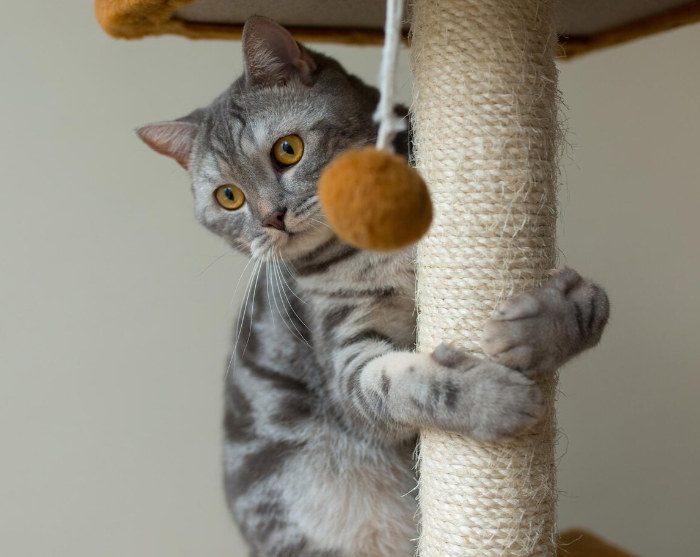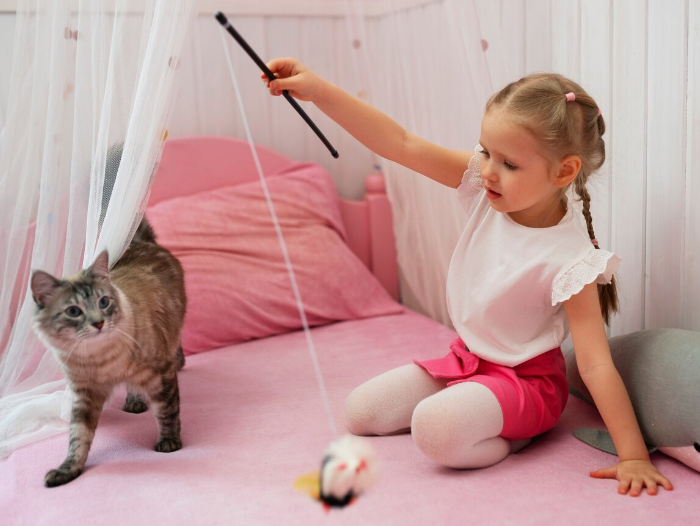2024-04-08
Doing exercise or otherwise being physically active is one of the prerequisites for a healthy life. When talking about exercise, we tend to think of humans only without considering the needs of our pets. Some of you may quickly object if you are dog owners and your paw friends are of an energetic breed such as the German Shepherd, the Jack Russel Terrier, or the Golden Retriever.
But what about cats? How many cat owners invest time to exercise their feline friends, and how important exercises are for cats?
If you are curious to find out, you should keep reading!
Yes, our feline friends need to stay healthy, both physically and mentally.
Regular physical activity will help improve their immune system, reduce the risk of medical conditions such as arthritis and diabetes, promote cardiovascular health, and prevent them from becoming overweight. The latter specifically applies to sprayed/neutered cats, who tend to gain weight. Proper nutrition, adapted to your cat’s specific needs along with regular exercise are essential for keeping your cat fit.
When it comes to mental health, keep in mind, that some cats tend to get bored easily and may develop unwanted behaviors or even depression if they are not physically and mentally stimulated. Destructive behaviors, stress, and even aggression can also occur due to the lack of physical and mental stimulation.

How Much Exercise Do Cats Need?
The most frequently recommended exercise duration for a cat is 30 minutes per day. However, this is rather general guidance, as the specific time duration should be adjusted to your cat’s health, age, and energy level.
If you have an adult cat, then 20 minutes a day should be sufficient. If you have a kitty, it is likely to be more energetic and need a longer time for physical activity- 30 minutes or longer. Senior cats may need 10–15 minutes a day.
Also, it is recommended that you divide your cat’s playtime/time to exercise into several short sessions throughout the day.
There are a few reasons for that:
-Cats are natural hunters who engage in a short but intense and highly energetic activity when hunting. Dividing their exercise time into short sessions mimics their natural hunting behavior;
-Cats may get overly enthusiastic during playtime, especially if they're having fun. Dividing playtime into shorter sessions helps prevent overexertion, which, in turn, ensures that your cat gets enough exercise without becoming overly fatigued;
-Our feline friends may get easily bored with repetitive activities. Splitting exercise into different sessions with various toys and activities helps keep your cat, interested and prevents them from getting bored;
-In contrast to the popular belief that cats are mostly active in the night, they reach the peak of their energy levels at dusk and dawn;
-If you want to bond with your kitty, you should spend time with them as frequently as possible. Dividing their playtime will help you establish a positive relationship with them, and reinforce wanted behaviors.

Before moving to the practical tips, we want to encourage you to supervise your cat when playing with toys. This is crucial for ensuring there are no potentially dangerous elements.
This specifically applies to any small detachable parts of the toys, that can be easily ingested by your cat.
If your cat is not much into physical activity, what better way to encourage them to exercise than using their natural hunting instinct to your advantage?
Provide your kitty with interactive toys to get them excited to hunt or just be physically active! There is a wide variety of toys on the market including (automatic) mouse toys, laser pointers, feather wands, and other types of cat teasers, snack balls, tower ball toys, etc.
Puzzle feeders and windmill cat toys are great options for providing your kitty with a combination of physical and mental stimulation, as they will need to put effort into getting the hidden treats/kibbles.
This type of toy will make your cat’s mealtime more stimulating, which will not only encourage physical activity but will also satisfy their hunting instincts as they search for hidden food.
Catnip is a herb containing the compound nepetalactone which is known for its stimulating effect on cats. It typically induces euphoria, which results in showing playful behaviors, such as rolling over and rubbing against it.
You can use small amounts of catnip during your cat’s play sessions, by sprinkling it on their toys or surfaces for scratching.
If you are not sure how your cat would react, you should do a test first and put a smidgen of catnip on the floor or your cat’s toys. Consulting with a veterinarian is also advisable, as they can give you correct guidance on what dose and how often you can use catnip.
Cat trees and platforms to climb will encourage your cat to remain active while helping them express their natural climbing instinct and diverting their attention from your furniture.
You might also use old pieces of furniture that you no longer use, or put any flat and sturdy objects into a stack to create an elevated surface for your feline friend.
Placing a window perch, or simply moving the climbing platform next to the window, will enable your kitty to observe the outside world. This is likely to motivate them to climb even more. Exercise and a nice view-what a great combo!
Why not be creative? You might remember the time when you were a kid and made tunnels, ramps, and hid in boxes, that created for you a whole new world. You can create a new world for your cat, too, that will keep her engaged and foster their agility skills.
Furthermore, you can use materials you have at hand like cardboard boxes or paper bags to create tunnels and obstacles that your cat will need to overcome to receive a treat. If you would like to bring this “agility course” to the next level, you can even buy weave pools or train your cat to walk up and down a ramp.
Agility exercises will help your cat remain fit and also improve their cognitive skills.
Cats regularly scratch various surfaces to remove the outer layer of their nails and keep them; release tension; stretch their muscles; and mark their territory. A scratching post or other types of pet-friendly furniture will keep your cat active and happy.
Since these pieces of furniture are elevated, your feline friend will also be able to climb them and observe their environment.
Creating a schedule for play sessions will be beneficial for your feline friend. As you may know, cats are creatures of habit and thrive on routine. Regular play sessions will also foster a good relationship with your cat, based on trust and mutual respect.
If you want to keep your cat motivated and prevent them from losing interest in the play sessions, you should provide them with several different types of toys and switch them regularly.
Rotate them after certain time, before your cat gets bored with them.
Understanding and meeting your cat's exercise needs is crucial for ensuring they will lead a long and healthy life. Do not neglect regular physical activity and mental stimulation as important aspects of your cat’s overall well-being.
By incorporating interactive toys, creating a cat-friendly environment, and engaging in regular play sessions, you can help improve your cat's health and strengthen your bond.